Last Stop on Market Street

by Matt de la Pena. Illustrated by Christian Robinson. ![]() Picture Book. 32 pages. Grades PreK-9.
Picture Book. 32 pages. Grades PreK-9.
Find this book: Amazon

Teacher's Guide
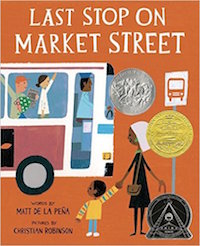
This picture book is truly extraordinary and, while delightful for the preschool set, can also be used with older students right up through middle school. An African-American child and his look-on-the-bright-side grandmother take a bus, after church, to a soup kitchen (though we don't find out their destination until the end). Along the way, the grandmother helps him appreciate the unexpected beauty in the city, especially in the people. The tone is quite light and playful while the themes explored are profound. It is so well regarded that it won the prestigious Newbery Medal, one of only two picture books ever to have won and the first by a Latino author.
As the story begins, CJ is feeling sorry for himself, "How come we gotta wait for the bus in all this wet?" Why don't they have a car? Why can't he play after church like his friends? Nana answers with child-like images to connect CJ to the wonders around him: a fire-breathing bus and trees drinking rain through straws.
The bus ride includes a conversation with a blind man and an impromptu concert by a man with a guitar. When they arrive at the "last stop", CJ asks, "How come it's always so dirty over here?" Nana replies, "Sometimes when you're surrounded by dirt, CJ, you're a better witness for what's beautiful."
They follow a disabled man and a homeless man down the street until they reach the soup kitchen where CJ and Nana do their weekly volunteer shift serving the meal.
De la Pena's text masterfully makes the city quite vivid to the reader with sights and sounds that will stay with you. Robinson's warm and colorful primitive-style illustrations of a diverse city (San Francisco?) are a great match for the simplicity of the story and for Nana's ability to find beauty in the basic humanity around them. The tone is reminiscent of Ezra Jack Keats' "Snowy Day" (see list of related books below).
I (Rebecca) can see why the Newbery Committee was impressed enough by this book to break with tradition and award it the medal. For teachers, this book is a wonderful starting point for discussions about attitude and values. It's a natural choice for units on community and it belongs in any discussion on beauty, gratitude or materialism. The story has enough complexity beneath the surface to reward a more literary analysis for older students and is therefore a great book for including diverse learners.
(Continued Below)
Advertisement:

Things to Talk About and Notice
- Language Arts, Reading Comprehension, Social Studies, Social Issues, Hunger: What is the "Last Stop on Market Street"? What are CJ and Nana doing there? What is a soup kitchen? Who eats there?
- Language Arts, Reading, Making Inferences, Emotions: Why is CJ upset at the beginning? How does his mood change? Why? Notice how he goes from complaining to noticing beauty, but also from wanting things to appreciating people.
- Values, Observation: Because finding beauty in unexpected places is explicitly stated in the text, that's a great place to start deeper discussions. What does it mean to say something or someone is beautiful? How would you define the word? What do people mean when they talk about "deeper beauty" or "inner beauty"? What are some examples from the book? What are some examples from your life?
- Social Skills, Emotions: While Nana's approach is certainly optimistic, she is also clearly acknowledging suffering and the importance of addressing it in that the trip is ultimately to feed the hungry. How do you know when to be grateful for what you do have and when to speak up when something isn't fair? How do you decide when to complain about something that's upsetting you and when to look on the bright side? Does it depend on who you're talking to? Can you force yourself to be grateful? For older students, you can discuss the fine line between optimism and denial.
- Language Arts, Reading, Themes:
Help students of all ages look for themes. Picture books are an especially good way for older students to practice looking for themes because they can read them over and over again as well as easily flip through the pictures to see the whole story at a glance. One theme is about appreciating what we have and not worrying about all the things we want. A related theme is the progression in the story from CJ's fixation on the things he wants to the "last stop" where he finds the joy of giving. Another theme is the finding of beauty in unexpected places, which CJ notices in Nana's finding "beautiful where he never even thought to look." Can you find others?
- Social Studies, Community, Transportation: What kind of public transportation does your town have, if any? What improvements would you like to see in your town's transportation?
- Social Skills, Emotions: Nana encourages CJ to stop complaining and to instead appreciate what he already has and the people around him. What helps you to be more appreciative? Are there people in your life like Nana who usually look at the good in a situation?
- Observation, Art Appreciation: The illustrations are almost primitive in style, that is, they look somewhat flat on the page without an attempt to make them more three-dimensional and realistic. Older students can discuss why they think the illustrator chose this style for this particular story?
- Language Arts, Characterization, Observation, Art Appreciation: Examine the illustrations for ways in which the illustrator has chosen different details for each character to make them individuals. You can see this particularly in the bus and soup kitchen scenes.

Activities
- Music: Of course, after reading this book to younger kids, you've got to sing "The Wheels on the Bus."
- Language Arts, Characterization, Writing, Art, Drawing: In the discussion section above I talked about noticing the details the illustrator chose to include to individuate the various characters. Choose someone in your family or a friend and draw them in a way that uses telling details. This could also be a prewriting activity.
- Values, Art, Photography, Observation: Go on an expedition to find beauty in a place not normally considered beautiful. A corner of the school yard? The parking lot? The janitor's closet? Back stage in the auditorium? Take cameras to document your finds.
- Values, Art, Photography, Observation: Send students home with inexpensive cameras to photograph unexpected beauty. Look at photographers' still life examples for inspiration online.
- Social Studies, Values, Emotions, Materialism: Set aside an hour and make a quick note anytime you find yourself wanting something. Take your list of wants and categorize them: necessities, basics, luxuries. Older students can look into how socioeconomic class shifts these columns?
- Emotions, Happiness, Observation, Sequencing: CJ's feelings change over the course of the story. Look for signs in the book for what he might be feeling. Make a two-column chart that follows the course of the story with the left column noting what he's doing or saying and the right column listing what he might be feeling.
- Science, Scientific Method, Psychology, Emotions, Happiness: Studies show that we aren't very good at knowing what will make us happy. It turns out that giving is the most reliable way of feeling happy. What do you think about that? Can you devise an experiment to test the theory for yourself?
- Social Studies, Community, Social Issues, Hunger: Collect food and then visit a soup kitchen to donate it.
- Language Arts, Vocabulary, Writing, Arts, Dance, Drawing, Physical Education: Pick out some of the unusual verbs in the story such as patter, lurch, swirl, and slice. Can you make drawings that illustrate them? Can you dance them? Substitute more common verbs into the sentences. How does it change the expressiveness of the text?
- Music Appreciation, Visualization, Art, Drawing: In the book CJ closes his eyes while the man is playing and visualizes many things. Put on music of a man singing with just a guitar (like some of James Taylor's pieces). Close your eyes and see what you can imagine. Draw some of the things you saw.
- Language Arts, Writing: Write about a relationship you have with an older relative or friend. What are they like? What do you like to do together? If you don't have an older person in your life write about what you think might be good about having a grandparent in your life.
(Continued Below)
Advertisement:

Related Books
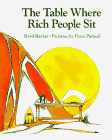
 Grades 1 - 12
Grades 1 - 12
The Table Where Rich People Sit by Byrd Baylor. Illustrated by Parnall, Peter. Picture Book. 32 pages.
Find this book: Local Bookstore, Amazon, B&N
A young girl insists that her family gather around their homemade table and discuss money. She says they don't have enough. They meet and make a list of their valuables and find that most are not monetary at all. This is a funny story with a serious message and the idea that money is an arbitrary and usually inadequate value system should be apparent to many readers. Read More.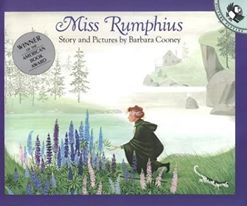
 Grades 2 - 4
Grades 2 - 4
Miss Rumphius by Barbara Cooney. Picture Book. 32 pages.
Find this book: Local Bookstore, Amazon, B&N
This beautiful picture book tells of the life of the author's great aunt Alice, now called The Lupine Lady. When she was little, Alice told her grandfather that she wanted to do as he did: go to far away places and live in a house by the sea. He told her that she must also do something to make the world more beautiful. Her solution of spreading lupine seeds wherever she walks leaves a blooming river in her wake. Read More.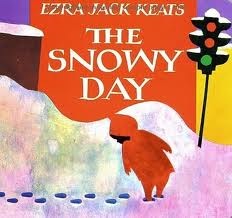
 Grades PreK - 1
Grades PreK - 1
The Snowy Day by Ezra Jack Keats. Picture Book. 40 pages.
Find this book: Local Bookstore, Amazon, B&N
In this Caldecott Medal winner, a little African-American boy experiences the snow in the city spending the day outside playing. He slides down a snow bank in his red snow suit, makes tracks through the snow, makes snow angels, and knocks snow from a tree onto his head. Afraid the snow won't last, Peter tries to keep a snowball in his pocket until the next day. Read More in our Featured Book Teachers Guide with discussion questions, extension activities, related books and links.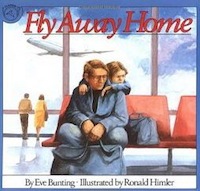
 Grades 1 - 5
Grades 1 - 5
Fly Away Home by Eve Bunting. Illustrated by Ronald Himler. Picture Book. 32 pages.
Find this book: Local Bookstore, Amazon, B&N
This is a sensitive book about a boy and his dad who live at the airport. Homelessness is not a common subject for any children's book and a picture book on this small family is a daring deed for Bunting and Himler to attempt. They had to walk a fine line to tell us this story. A misstep in any direction would have brought condescension, oversimplification, false cheerfulness or hopelessness and Fly Away Home is free of all those things. Read More in our Featured Book Teachers Guide with discussion questions, extension activities, related books and links.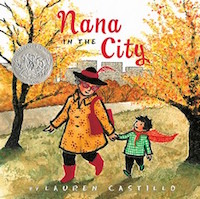
 Grades PreK - 3
Grades PreK - 3
Nana in the City by Lauren Castillo. Picture Book. 40 pages.
Find this book: Local Bookstore, Amazon, B&N
When a young boy goes to the city to stay with his Nana he is overwhelmed and frightened by all the sights and sounds. Nana knits him a super hero cape to give him courage and together they explore the city. This is a great book for overcoming our fear of things that are new and different and for learning to appreciate the world around us.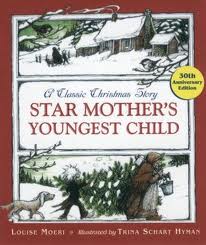
 Grades 2 - 6
Grades 2 - 6
Star Mother's Youngest Child by Louise Moeri. Illustrated by Hyman, Trina Schart. Picture Book. 48 pages.
Find this book: Local Bookstore, Amazon, B&N
A lonely old woman shouts her loneliness at the Christmas sky on Christmas Eve. In the sky a young star child asks his mother for a chance to celebrate Christmas on earth. When the child shows up at her door, the old woman reacts with selfishness and anger until the child's warmth changes everything.
(Continued Below)
Advertisement:

Related Areas Within Carol Hurst's Children's Literature Web Site
- Cities and Towns through Kids' Books: Featured Subject Classroom Unit, Preschool through 3rd grade with classroom activities, related books and links.
- Using Picture Books with Older Students: Rationale and techniques for using picture books right up through high school.
- Free Teacher's Guides: A listing of all our teacher's guides. Picture Books, Nonfiction and Fiction.

